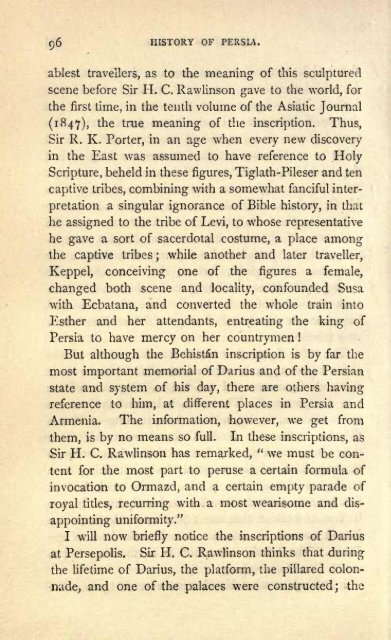Persia from the Earliest Period to the Arab
Persia from the Earliest Period to the Arab
Persia from the Earliest Period to the Arab
You also want an ePaper? Increase the reach of your titles
YUMPU automatically turns print PDFs into web optimized ePapers that Google loves.
96<br />
HISTORY OF PERSIA.<br />
ablest travellers, as <strong>to</strong> <strong>the</strong> meaning of this sculptured<br />
scene before Sir H. C. Rawlinson gave <strong>to</strong> <strong>the</strong> world, for<br />
<strong>the</strong> first time, in <strong>the</strong> tenth volume of <strong>the</strong> Asiatic Journal<br />
(1847), <strong>the</strong> true meaning of <strong>the</strong> inscription. Thus,<br />
Sir R. K. Porter, in an age when every new discovery<br />
in <strong>the</strong> East was assumed <strong>to</strong> have reference <strong>to</strong> Holy<br />
Scripture, beheld in <strong>the</strong>se figures, Tiglath-Pileser and ten<br />
captive tribes, combining with a somewhat fanciful inter-<br />
pretation a singular ignorance of Bible his<strong>to</strong>ry, in that<br />
he assigned <strong>to</strong> <strong>the</strong> tribe of Levi, <strong>to</strong> whose representative<br />
he gave a sort of sacerdotal costume, a place among<br />
<strong>the</strong> captive tribes ; while ano<strong>the</strong>r and later traveller,<br />
Keppel, conceiving one of <strong>the</strong> figures a female,<br />
changed both scene and locality, confounded Susa<br />
with Ecbatana, and converted <strong>the</strong> whole train in<strong>to</strong><br />
Es<strong>the</strong>r and her attendants, entreating <strong>the</strong> king of<br />
<strong>Persia</strong> <strong>to</strong> have mercy on her countrymen !<br />
But although <strong>the</strong> Behistfin inscription is by far <strong>the</strong><br />
most important memorial of Darius and of <strong>the</strong> <strong>Persia</strong>n<br />
state and system of his day, <strong>the</strong>re are o<strong>the</strong>rs having<br />
reference <strong>to</strong> him, at different places in <strong>Persia</strong> and<br />
Armenia. The information, however, we get <strong>from</strong><br />
<strong>the</strong>m, is by no means so full. In <strong>the</strong>se inscriptions, as<br />
Sir H. C. Rawlinson has remarked, " we must be con-<br />
tent for <strong>the</strong> most part <strong>to</strong> peruse a certain formula of<br />
invocation <strong>to</strong> Ormazd, and a certain empty parade of<br />
royal titles, recurring<br />
appointing uniformity."<br />
with a most wearisome and dis-<br />
I will now briefly notice <strong>the</strong> inscriptions of Darius<br />
at Persepolis. Sir H. C. Rawlinson thinks that during<br />
<strong>the</strong> lifetime of Darius, <strong>the</strong> platform, <strong>the</strong> pillared colon-<br />
nude, and one of <strong>the</strong> palaces were constructed; <strong>the</strong>

















